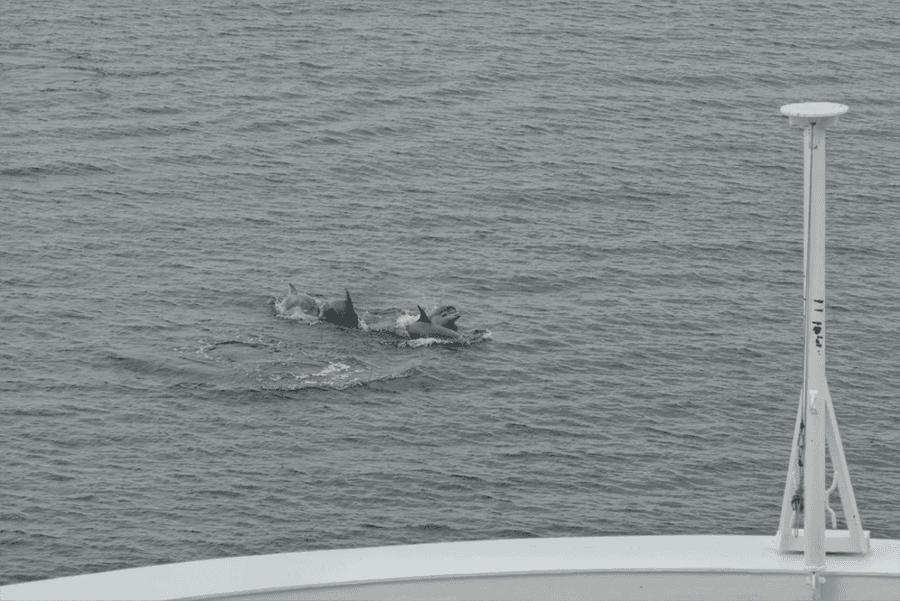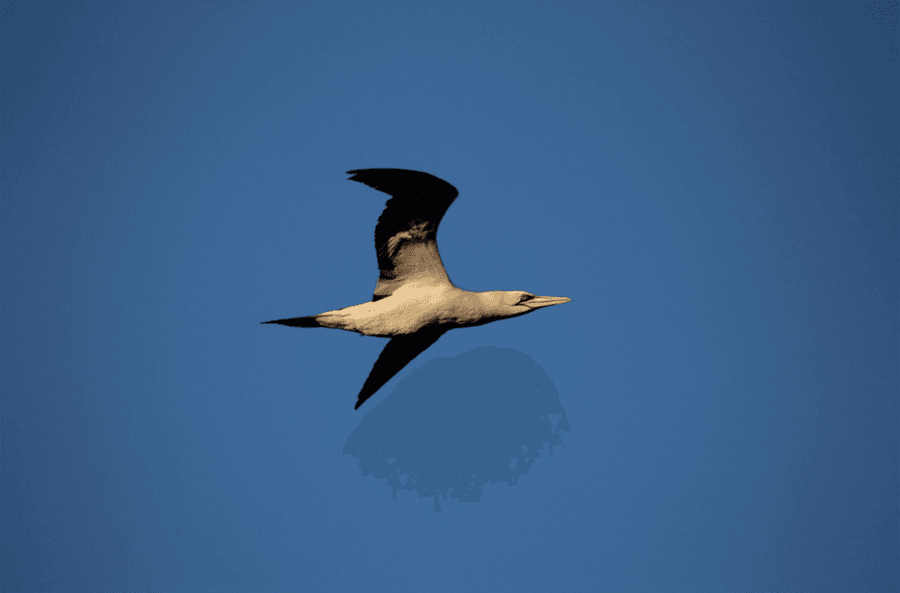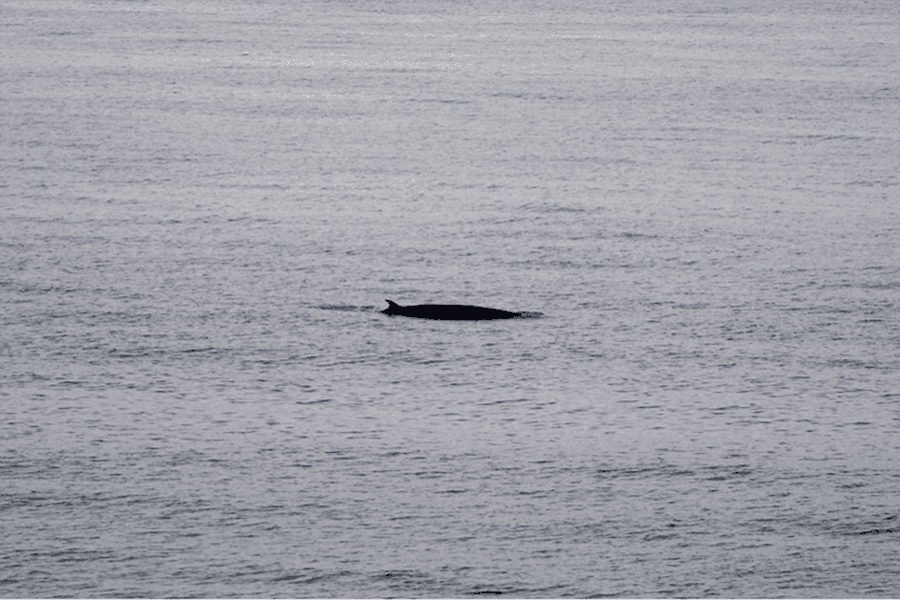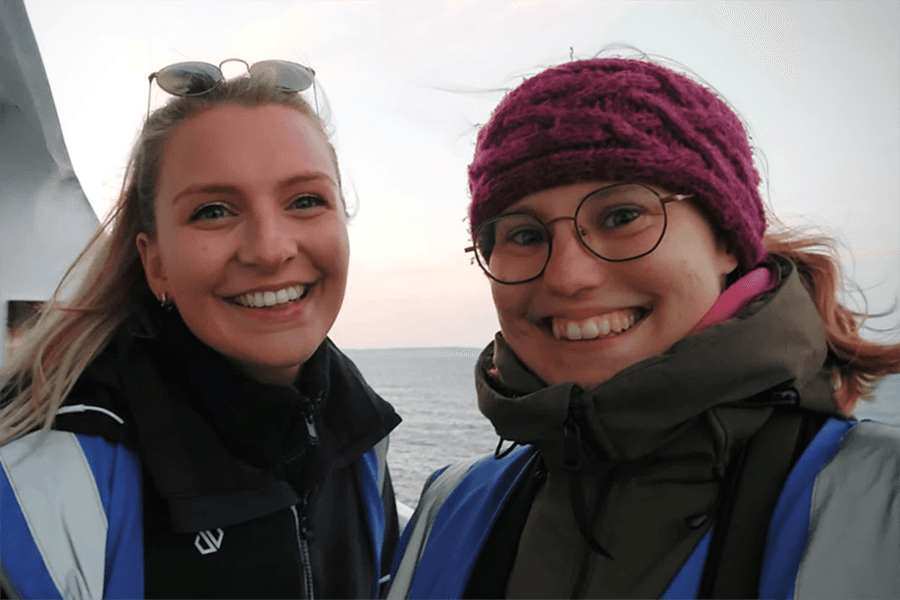Hello everyone, Nina & Mathilde here with a roundup of our time onboard King Seaways, which has been our home during the North Sea season.
Back in March, I (Mathilde) embarked on the King, filled with anticipation of what might be seen during the season. For me, it feels like time has flown by within the blink of an eye. Since March, Nina and I have rotated every two weeks, and during our time onboard, we have talked to many passengers and seen a number of cetacean species that the North Sea is home to.
Across the season, we’ve had some truly unforgettable wildlife sightings. Bottlenose dolphins have interacted with and approached the ship, breaching and bow-riding on several occasions. One evening, leaving the port of Tyne, we saw several bottlenose dolphin calves leaping excitedly out of the water, showing their pale bodies and foetal folds to thrilled onlookers. We’ve also had many white-beaked dolphins launching themselves out of the water and making a real splash, sometimes near to the ship but often a little further out, closer to the coast. They have striking white blazes along their flanks, so are quite easy to identify from a distance, and are always a lovely species to observe. As well as many dolphins, we have seen several shy harbour porpoises swim away from the ship. These are often sighted in smaller pods or sometimes individually. Minke whales have also glided past the ship and, on occasion, have breached on the horizon. These are the four main cetacean species found to inhabit the North Sea. In addition to these four, we have also spotted some common dolphins, which is quite uncommon for this region. We have also had some ‘unidentified’ whales pop up here and there; some looking bigger than minke whales, and, therefore, a bit of a mystery. Most of these whales were either too far away or didn’t show enough of themselves for a positive ID… the challenges of being an Ocean Conservationist!
Some encounters have been more concerning, for example, a minke whale suddenly surfaced just in front of the ship, which was a very close call, but thankfully it safely passed us. These kinds of encounters indicate the importance of our work, as ship strike is one of the most common threats facing cetaceans. It is important to communicate with the bridge and other crew members and make sure they know what to do if a similar situation occurs.
Mathilde’s Highlights
I personally loved seeing all the cetaceans. Some encounters, however, were a little more special than others. During the summer, on a perfectly calm day, just before sunset, a porpoise surfaced straight in the view of my binoculars, and I saw the blow of a porpoise! This is quite rare to see as porpoises are small, and often their blow is very discreet. My first proper leaping white-beaked dolphins were a memorable sighting as well, in combination with the passengers slowly starting to see them as well. I saw them very far on the horizon as large splashes and shouted out, and slowly one after the other, passengers started seeing them. I love the excitement that ripples through the passengers on the observation deck (like a Mexican wave!) when animals are sighted. I also loved helping passengers spot their very first whale – sharing these encounters makes me smile. Sometimes, bottlenose dolphins can be seen between the piers and the Tyne river mouth. The first time I saw this was incredible; I was just starting my survey as we were leaving port, when, out of the corner of my eye, I saw a splash. Many more splashes followed, and both adults and young bottlenose dolphins suddenly rushed towards the ship and started bow-riding.

But my most special encounter had to be the super pod of harbour porpoises! It was a calm, early morning on our way to the port of Tyne, and some early bird passengers had already joined me out on deck, sharing some minke whale sightings just after sunrise. All of a sudden, we saw lots of splashes on the horizon coming toward us. My initial thought was dolphins - a very large pod of dolphins. The animals were quite small, so it was difficult to get an idea of how many there were and what species. In the beginning, I was quite confused as the behaviour was so dolphin-like, but through my binoculars and seeing the photos/videos we all took, it slowly started to dawn on me that these were actually harbour porpoises. The shy, solitary animals were suddenly porpoising in a very, very large group. What was happening? Sometimes, larger aggregations of harbour porpoises occur, but it is rarely observed. These aggregations mostly happen due to feeding and seasonal movements. At one point, the ship was surrounded on all sides by harbour porpoises! So many passengers came to me asking me what we were seeing. In the end, my estimation was that we had seen at least 300 harbour porpoises, if not more. It was a true porpoise party!

Nina’s Highlights
If you’ve seen some of my previous posts, you’ll know that the weather across the North Sea is ever-changing, and no two days are the same. We’ve had countless storms, swells of up to 4 metres and torrential rain, as well as mirror calm conditions, blazing sunshine and gorgeous sunsets! All in all, it has been a real mixture on the weather front but an incredibly rewarding experience nonetheless! I have thoroughly enjoyed seeing the many faces of the North Sea and how wildlife behaves in different conditions. It has been a fantastic experience to hone in on my seabird ID skills and really get to grips with different species and their breeding habits, migration patterns and seasonal plumage! One of my favourite species is the northern gannet, which has the largest wingspan (2m) of birds in this region. They can dive at speeds of up to 45mph and have special vertebrae in their necks that lock in place before entry into the water. It’s always really amazing to see northern gannets diving, or Manx shearwaters clustered above the water’s surface, feeding in a frenzy. Birds are excellent indicators of cetacean activity as they often feed on similar prey. A number of diving gannets one morning led me to spot two extremely energetic white-beaked dolphins leaping about closer to the coast. My favourite seabirds are the Atlantic puffins. Their summer beaks and orange feet are so bright and colourful and always make me smile! On occasion, I have glimpsed pufflings too, which are baby puffins. They have similar characteristics to guillemots and bob under the surface when ships approach - they are much better swimmers than they are fliers at a young age!

My favourite moment on board, however, has to be during our minke whale season in late August. In a single week, we had approximately 47 minke whale sightings along the route, mostly in mirror calm conditions and around Whitby and Staithes, UK. Many guests were out on the observation deck shouting and pointing as they saw the long, dark grey backs of minke whales roll above the water and small, curved dorsal fins break the surface. Several people said they had never seen a whale before until these sightings, and it was really heart-warming to share these wildlife encounters with people from all around the world. We even had a mystery breaching whale making a huge splash out on the horizon one evening. It was too far away to confirm a positive ID – my thoughts were either a humpback or a minke whale. It breached in the typical minke fashion, outstretched almost horizontally before crashing back down, but I settled for ‘unidentified whale’ in the end as I couldn’t be 100% sure. It was fascinating to see the sheer size of the splashes, even from such a distance!

It's not just the wildlife sightings that have made the North Sea season one to remember! We have had some incredibly insightful conversations with people from all walks of life, who have travelled across different oceans and had wonderful wildlife encounters. We have also had some difficult conversations with guests on board the King, raising awareness about some of the threats facing cetaceans, particularly as the North Sea is a busy shipping area and is home to noise pollution and industrial fishing. It is important to raise awareness about these issues and share our knowledge so we can better protect whales, dolphins and porpoises and their habitats for future generations!
See you next season!


